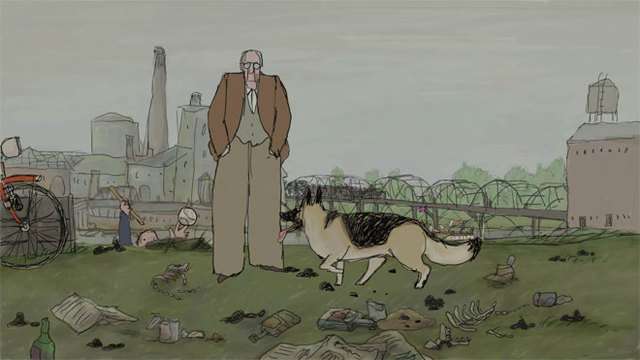 Dog days are good days
Dog days are good daysJ.R. Ackerley was a writer for the BBC from its foundation in the late Twenties till 1959 who was openly gay, a thing unusual for the time. He wrote with wit, bluntness, and honesty about his remote, but important, relationship with his colorful dad in his remarkable little book
My Father and Myself. His semi-autobiographical novel,
We Think the World of You, was made into the 1988 film by Colin Gregg with Alan Bates, Max Wall, Liz Smith and Gary Oldman. Despite plenty of sex in his younger years, he never found a life companion in maturity, and he found that the most important emotional connection of his adult life was his relationship with his canine pet, his "Alsatian bitch," which he described in another book,
My Dog Tulip. (The dog's actual name, by the way, was Queenie. )
This hand-drawn animated film, which is narrated by Christopher Plummer and includes the voices of Lynn Redgrave, Isabella Rossellini, and others, was adapted from that book. The images are of the charming, old-fashioned, wavery sort, a mixture of black and white line drawings and (more often) drawings colored in with watercolor. The entire film is constantly narrated by lines from the book. Somewhat oddly, when you see Ackerley on screen, he is usually represented as mouthing the words of the voiceover. You can ask yourself if the images were needed, since the words tell he same story. Sometimes events are understood better and more fully experienced in the mind's eye than when drawn for us with painful (or even witty) literalism. But the film brings the book, and Ackerley's wit and honesty, to a new audience.
The book certainly is suited to animation rather than other form, since it consists so largely of events it would be difficult to stage and unpleasant to watch. Events, that is, like Tulip relieving herself at untimely moments, "marking" objects outdoors; and a lengthy effort to mate Tulip with a male Alsatian. The latter fails, though she eventually mates with a little mutt and has eight puppies, which Ackerley is immediately forced by his landlord to get rid of. He considers drowning them, but gives them away. He admits he doesn't do so responsibly, since he kept no track of where they went. And Tulip herself had an unfortunate upbringing, which Ackerley thought led to her skittishness, excessive barking, and almost pathological eagerness to go on walks.
Ackerley took in his adult sister for a time in his Putney flat, partly to keep Tulip company while he was at work. A competition developed for Tulip's affections, but Ackerley won. There are various other characters, rude shopkeepers, owners of would-be mates for Tulip. Through a weekend with a former fellow officer we learn something about Ackerley's service in WWI.
This film is amusing. It is accurate in a way most accounts of canine pets are not. You won't get the profound understanding of canines of a Konrad Lorenz or César Milan. In fact Ackerley dramatizes how comically ignorant humans are of dogs' inner workings.
The book does not tell all. Its focus is very limited. Ackerley's relationship with Tulip (Queenie) was central in his life during those 16 years, which he says were the happiest of his life. Elsewhere we learn they were his most productive, partly because of his happy state, partly because Tulip's behavior in company reduced Ackerley's social life and so gave him more time to be writing. Considering that this was the relationship's central importance there might have been more about the physical affection between man and dog, the companionship, and how Ackerley drew sustenance from these. It seems somewhat peculiar that when Ackerley is talking about the more complex side of male-female canine relations the animators switch to black-and-white drawings of upright humans with canine heads and paws. It's their choice, not Ackerley's. Oddly, there is nothing about feeding the dog. But you clearly see how much of Ackerley's life was devoted to Tulip's needs, and you get a sense of how satisfying that was to him.
Despite shortcomings,
My Dog Tulip is a significant contribution to the literature of canine-human relations and a chance to hear a wonderfully dry, articulate English voice of the Fifties. The film premiered at Cannes and was well received at Annency, Vancouver, Toronto, and other festivals. I saw it as part of the San Francisco International Film Festival in April 2010.





